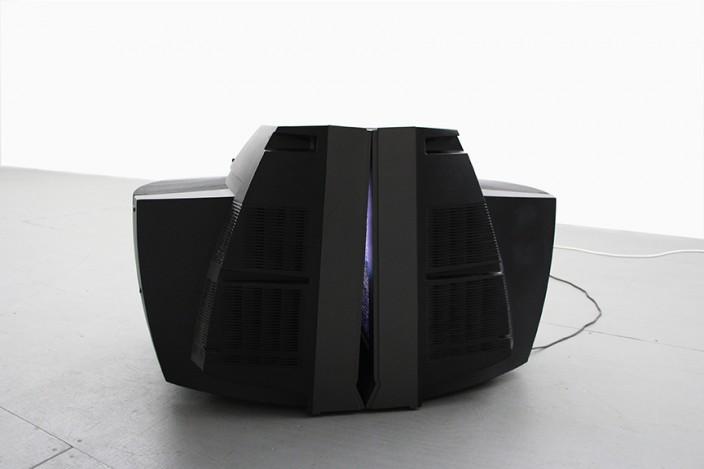
Takahiko Iimura, TV for TV, 1983, Two identical TV monitors face to face, Dimensions variable
Before Projection: Video Sculpture, 1974–1995
MIT List Visual Arts Center
20 Ames Street, Bldg. E15-109 Cambridge, MA 02139
Hayden and Reference Galleries
February 8–April 15, 2018
Opening Reception: Wednesday, February 7, 6–8 PM
Cambridge, MA—Before Projection: Video Sculpture 1974–1995 shines a spotlight on a body of work in the history of video art that has been largely overlooked since its inception. The exhibition explores the connections between our current moment and the point just before video art was transformed dramatically by the entry of large-scale, cinematic installation into the gallery space. The exhibition will present a re-evaluation of monitor-based sculpture since the mid-1970s with a tightly focused survey of works that have been rarely seen in the last twenty years, presenting both canonical artists and figures little known in the United States.
From video art’s beginnings, artists engaged with the sculptural properties of the television set, as well as the possibilities afforded by combining multiple moving images next to each other. Artists assembled monitors in multiple configurations and video walls, and, from the 1980s onwards, incorporated TV sets into elaborate environments and architectural settings. In concert with technological advances, video editing and effects also grew more sophisticated. These video works articulated a range of conceptual and thematic concerns related to the television medium, the still and moving image, seriality, figuration, landscape, and identity. The material heft of the cube monitor (before the advent of the flat screen) also anchored these works firmly in three-dimensional space and sculpture. Before Projection focuses on the period after very early experimentation in video and before video art’s full arrival—coinciding with the wide availability of video projection equipment—in the gallery and museum alongside painting and sculpture. While video sculpture is clearly situated alongside, rather than in isolation from, single-screen tapes and projection, this exhibition highlights specific kinds of works that fell out of favor almost instantly in the mid-1990s and have received little critical attention since.
Ernst Caramelle’s Video Pong-Pong (1974), made at MIT while the artist was a fellow at the Center for Advanced Visual Studies (CAVS), examines the relationship between the human body and video by recording a ping-pong match, which is played back on two monitors mounted on AV carts at approximately eye level and positioned in front of a “real” ping pong table. The early two-channel video installation Attack Piece (1975) by Dara Birnbaum consists of two monitors facing each other. One shows a series of still photographs of men armed with Super 8 cameras intruding on the photographer’s (Birnbaum) visual field, while the opposing monitor presents the film footage taken simultaneously of her. Transferred to video, the spectator becomes caught in a visual attack field that considers the apparatus of the camera, gender dynamics, as well as the relationship between celluloid and the electronic video signal. For Equinox (1979), a subversive meditation on nature and video, Mary Lucier trained her video camera onto the sun for twelve consecutive days, burning the camera tube and leaving more and more marks on the images, which are then presented on seven pedestal-mounted monitors of increasing size. Shigeko Kubota’s River (1979-81), contemplating the flow of the electronic signal and her idea of video as “liquid reality,” mounts three monitors above a trough filled with water reflecting images, including those of herself swimming in gentle waves. Takahiko Iimura’s TV for TV (1983) performs the humorous gesture of turning the screens of two television sets to each other so that the unrelenting broadcast signal plays only to technology itself. Maria Vedder’s rarely shown PAL or Never the Same Color (1988), which will be reconstructed for the exhibition, employs one of the earliest video wall systems and looks at the different broadcast standards established in Europe and North America—PAL and NTSC—while considering their aesthetic and geopolitical implications. In her early work Snake River (1994), Diana Thater, who represents a younger generation of artists working in video, utilizes three monitors, each displaying footage in one of the three primary colors—red, green, or blue—which together make a full-color image on a CRT monitor. This tactic makes visible the "additive" system of color mixing, which is usually imperceptible, highlighting not only technological standards but also the mechanics of human visual perception.
Artists in the exhibition are Dara Birnbaum, Ernst Caramelle, Takahiko Iimura, Shigeko Kubota, Mary Lucier, Muntadas, Tony Oursler, Nam June Paik, Friederike Pezold, Adrian Piper, Diana Thater, and Maria Vedder.
Before Projection: Video Sculpture 1974-1995 is curated by Henriette Huldisch, Director of Exhibitions & Curator, MIT List Visual Arts Center.
The exhibition is presented as part of a citywide partnership of arts and educational institutions organized to recognize the outsized role greater Boston has played in the history and development of technology. The Institute of Contemporary Art/Boston initiated this partnership to link concurrent exhibitions and programs related to the themes of the ICA exhibition Art in the Age of the Internet, 1989 to Today.
Learn more about the collaboration during a special media preview of Art in the Age of the Internet, 1989 to Today led by Eva Respini, the ICA's Barbara Lee Chief Curator. Director Paul C. Ha and Director of Exhibitions and Curator Henriette Huldisch from the MIT List Visual Arts Center, along with directors and curators from other partner institutions, will be in attendance and available for media interviews.






















![DEl Kathryn Barton [Australian b. 1972] the more than human love , 2025 Acrylic on French linen 78 3/4 x 137 3/4 inches 200 x 350 cm Framed dimensions: 79 7/8 x 139 inches 203 x 353 cm](/sites/default/files/styles/image_5_column/public/ab15211bartonthe-more-human-lovelg.jpg?itok=wW_Qrve3)



